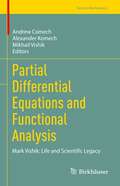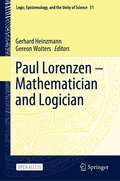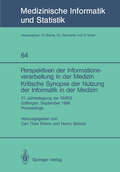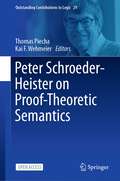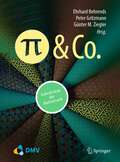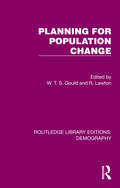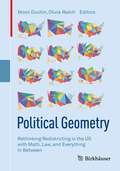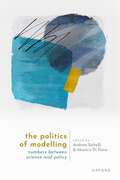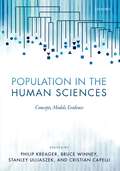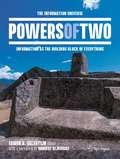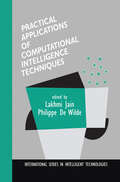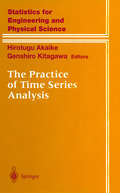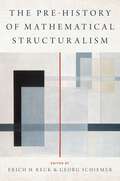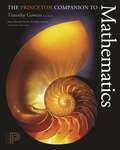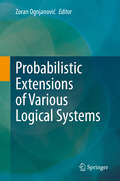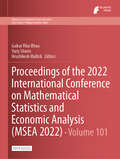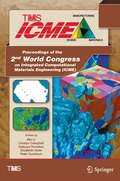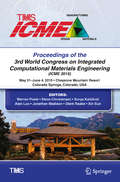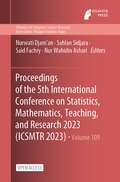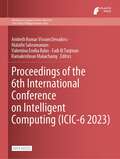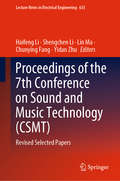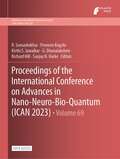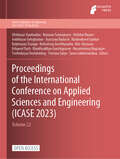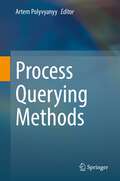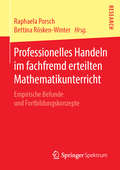- Table View
- List View
Partial Differential Equations and Functional Analysis: Mark Vishik: Life and Scientific Legacy (Trends in Mathematics)
Mark Vishik was one of the prominent figures in the theory of partial differential equations. His ground-breaking contributions were instrumental in integrating the methods of functional analysis into this theory.The book is based on the memoirs of his friends and students, as well as on the recollections of Mark Vishik himself, and contains a detailed description of his biography: childhood in Lwów, his connections with the famous Lwów school of Stefan Banach, a difficult several year long journey from Lwów to Tbilisi after the Nazi assault in June 1941, going to Moscow and forming his own school of differential equations, whose central role was played by the famous Vishik Seminar at the Department of Mechanics and Mathematics at Moscow State University. The reader is introduced to a number of remarkable scientists whose lives intersected with Vishik’s, including S. Banach, J. Schauder, I. N. Vekua, N. I. Muskhelishvili, L. A. Lyusternik, I. G. Petrovskii, S. L. Sobolev, I. M. Gelfand, M. G. Krein, A. N. Kolmogorov, N. I. Akhiezer, J. Leray, J.-L. Lions, L. Schwartz, L. Nirenberg, and many others.The book also provides a detailed description of the main research directions of Mark Vishik written by his students and colleagues, as well as several reviews of the recent development in these directions.
Paul Lorenzen -- Mathematician and Logician (Logic, Epistemology, and the Unity of Science #51)
This open access book examines the many contributions of Paul Lorenzen, an outstanding philosopher from the latter half of the 20th century. It features papers focused on integrating Lorenzen's original approach into the history of logic and mathematics. The papers also explore how practitioners can implement Lorenzen’s systematical ideas in today’s debates on proof-theoretic semantics, databank management, and stochastics. Coverage details key contributions of Lorenzen to constructive mathematics, Lorenzen’s work on lattice-groups and divisibility theory, and modern set theory and Lorenzen’s critique of actual infinity. The contributors also look at the main problem of Grundlagenforschung and Lorenzen’s consistency proof and Hilbert’s larger program. In addition, the papers offer a constructive examination of a Russell-style Ramified Type Theory and a way out of the circularity puzzle within the operative justification of logic and mathematics. Paul Lorenzen's name is associated with the Erlangen School of Methodical Constructivism, of which the approach in linguistic philosophy and philosophy of science determined philosophical discussions especially in Germany in the 1960s and 1970s. This volume features 10 papers from a meeting that took place at the University of Konstanz.
Perspektiven der Informationsverarbeitung in der Medizin Kritische Synopse der Nutzung der Informatik in der Medizin: 31. Jahrestagung der GMDS Göttingen, September 1986 Proceedings (Medizinische Informatik, Biometrie und Epidemiologie #64)
Eriiffnung Aktuelle Herausforderungen der medizinischen Informationsverarbeitung Selbmann. H. -K. 3 Grundsatzreferate Die Rolle der Epidemiologie fUr die Gesundheitspolitik Suj3muth. R. 9 Organisation des Gehirns und artifizielle Intelligenz Creutzfeldt. O. D. 10 Informatik im Wandel Seegmuller. G. 11 Einfiihrung in die Thematik der Tagung Kritische Synopse der Nutzung der Informatik in der Medizin. - Aus der Sicht der praktischen Erfahrung - Ehlers. C. Th. 17 Perspektiven der Datenverarbeitung in der klinischen Medizin Just. H. 23 Gesundheitsiikonomie und Planung Indikatorensysteme fiir die Krankenhausplanung Eimeren van. W. 29 Das Mikrosimulationssystem des Sonderforschungsbereiches 3: ein Analyseinstrument fiir Ver1lnderungsvorschl1lge der Gesundheitssicherung Brennecke. R. 35 Diagnosebezogene Abrechnungssysteme und ihr EinfluB auf die Struktur der Krankenhauser Kampe. D. M. 40 Budgetierung und Fallkosten-Abrechnung 44 Hildebrand. R. Klinische Diagnosendokumentation Vier Jahrzehnte Dokumentation in der Inneren Medizin. Erwartungen und Erfahrungen 51 Fritze. E. IV Die Nutzung der Basisdokumentation im Medizinischen Infor mationssystem Kiel (MEDIK) Hedderich, J" K, Sauter, K, Carstensen 57 Diagnosenstatistik nach der neuen BPflV und Ausbau zu einer Basisdokumentation Muhs, G. , R. Sawinski, P. Haas, J. R. Mohr 61 Konzeption und Implementierung eines DV -gestiitzten Diagnose erfassungs- und -Auswertungssystems Bulzebruck, H. 65 Auswirkung von Schweregrad der Krankheit und Multimor biditat auf Aufenthaltsdauer und Komplikationsrate Thurmayr, R. 70 Der Hornheider Weg vom Dokumentations- zum Informations system. - Ein struktur- und bedarfsorientierter Weg - Lippold, A. , H. Drepper 74 Offentliches Gesundheitswesen und Epidemiologie Organisatorische und datenschutzrechtliche Gesichts punkte bei der Validierung von Mortalitatsdaten Giersiepen, K. , E.
Peter Schroeder-Heister on Proof-Theoretic Semantics (Outstanding Contributions to Logic #29)
This open access book is a superb collection of some fifteen chapters inspired by Schroeder-Heister's groundbreaking work, written by leading experts in the field, plus an extensive autobiography and comments on the various contributions by Schroeder-Heister himself. For several decades, Peter Schroeder-Heister has been a central figure in proof-theoretic semantics, a field of study situated at the interface of logic, theoretical computer science, natural-language semantics, and the philosophy of language. The chapters of which this book is composed discuss the subject from a rich variety of angles, including the history of logic, the proper interpretation of logical validity, natural deduction rules, the notions of harmony and of synonymy, the structure of proofs, the logical status of equality, intentional phenomena, and the proof theory of second-order arithmetic. All chapters relate directly to questions that have driven Schroeder-Heister's own research agenda and to which he has made seminal contributions. The extensive autobiographical chapter not only provides a fascinating overview of Schroeder-Heister's career and the evolution of his academic interests but also constitutes a contribution to the recent history of logic in its own right, painting an intriguing picture of the philosophical, logical, and mathematical institutional landscape in Germany and elsewhere since the early 1970s. The papers collected in this book are illuminatingly put into a unified perspective by Schroeder-Heister's comments at the end of the book. Both graduate students and established researchers in the field will find this book an excellent resource for future work in proof-theoretic semantics and related areas.
Pi und Co.: Kaleidoskop der Mathematik
Mathematik ist eine vielseitige und lebendige Wissenschaft. Von den großen Themen wie Zahlen, Unendlichkeiten, Dimensionen und Wahrscheinlichkeiten spannen die Autoren einen Bogen zu den aktuellen mathematischen Anwendungen in der Logistik, der Finanzwelt, der Kryptographie, der Medizin und anderen Gebieten. Das Buch versammelt verständliche, unterhaltsame Texte ebenso wie anspruchsvollere mathematische Herausforderungen und bietet damit Lesern die Chance, einen ganz individuellen Zugang zu dieser spannenden Wissenschaft zu finden.
Planning for Population Change (Routledge Library Editions: Demography #6)
Originally published in 1986, this book explores many important aspects of the relationship between population change and planning, exploring the impact of population change on service provision and its impact on the policy-making process. In all countries, whether their population is expanding. ageing or stagnating, population mobility is an important cause of economic and social development. This book argues that there is a need for greater sensitivity about population change in policy-making and service provision and suggests ways of achieving this.
Political Geometry: Rethinking Redistricting in the US with Math, Law, and Everything In Between
“Why does my congressional district look like a salamander?” Politically engaged citizens have been asking this question for far too long. This volume collects perspectives from a wide cross-section of disciplines to explain what drives gerrymandering, why it can be hard to stamp out, and how we might go about fixing it. With topics ranging from the Voting Rights Act to Markov chains to the geography of communities, this book serves as a 21st century toolkit for how we can better approach this corrosive phenomenon.The volume editors gather experts from a variety of fields to provide as many different perspectives on gerrymandering as possible. Thanks to the breadth of expertise found across these chapters, ranging from lawyers to mathematicians to civil rights activists, readers will discover new ways of thinking about redistricting in the United States. Illustrations and helpful walkthroughs appear throughout to clearly explain otherwise complex ideas from these areas. Political Geometry is a must-have for anybody interested in political representation in the United States elections, and for anyone who’s ever thought, “There must be a better way to do this.”
The Politics of Modelling: Numbers Between Science and Policy
Chapter 2, 'Pay no attention to the model behind the curtain', Chapter 4, 'Mind the hubris: Complexity can misfire', and Chapter 8, ' Sensitivity auditing: A practical checklist for auditing decision-relevant models' are published open access and free to read or download from Oxford Academic The widespread use of mathematical models for policy-making and its social and political impact are at the core of this book. While the discussion of mathematical modelling generally centres around technical features, use, and type of model, the literature is increasingly acknowledging that the social nature of modelling, its biases and responsibilities, are equally worth investigating. This book tackles these emerging questions by adopting a multidisciplinary approach to investigate how current modelling practices address contemporary challenges, and fills a gap in the field, which has historically focused on statistical and algorithmic modes of producing numbers. Thanks to its multidisciplinary appeal, this book will be essential reading for modellers, public officials, policymakers, and scholars alike.
Population in the Human Sciences: Concepts, Models, Evidence
The Human Sciences address problems in nature and society that often require coordinated approaches of several scientific disciplines and scholarly research, embracing the social and biological sciences, and history. When we wish, for example, to understand how some sub-populations and not others come to be vulnerable, why a disease spreads in one part of a population and not another, or which gene variants are transmitted across generations, then a remarkable range of disciplinary perspectives need to be brought together, from the study of institutional structures, cultural boundaries, and social networks down to the micro-biology of cellular pathways, and gene expression. The need to explain and address differential impacts of pressing contemporary issues like AIDS, ageing, social and economic inequalities, and environmental change, are well-known cases in point. Population concepts, models, and evidence lie at the core of approaches to all of these problems, if only because accurate differentiation and identification of groups, their structures, constituents, and relations between sub-populations, are necessary to specify their nature and extent. The study of population thus draws both on statistical methodologies of demography and population genetics and sustained observation of the ways in which populations and sub-populations are formed, maintained, or broken up in nature, in the laboratory, and in society. In an era in which research needs to operate on multiple levels, population thinking thus provides a common ground for communication and critical thought across disciplines. Population in the Human Sciences addresses the need for review and assessment of the framework of interdisciplinary population studies. Limitations to prevailing postwar paradigms like the Evolutionary Synthesis and Demographic Transition were becoming evident by the 1970s. Subsequent decades have witnessed an immense expansion of population modelling and related empirical inquiry, with new genetic developments that have reshaped evolutionary, population, and developmental biology. The rise of anthropological and historical demography, and social network analysis, are playing major roles in rethinking modern and earlier population history. More recently, the emergence of sub-disciplines like biodemography and evolutionary anthropology, and growing links between evolutionary and developmental biology, indicate a growing convergence of biological and social approaches to population.
Powers of Two: The Information Universe — Information as the Building Block of Everything
Is everything Information? This is a tantalizing question which emerges in modern physics, life sciences, astronomy and in today’s information and technology-driven society. In Powers of Two expert authors undertake a unique expedition - in words and images - throughout the world (and scales) of information. The story resembles, in a way, the classic Powers of Ten journeys through space: from us to the macro and the micro worlds . However, by following Powers of Two through the world of information, a completely different and timely paradigm unfolds. Every power of two, 1, 2, 4, 8…. tells us a different story: starting from the creation of the very first bit at the Big Bang and the evolution of life, through 50 years of computational science, and finally into deep space, describing the information in black holes and even in the entire universe and beyond…. All this to address one question: Is our universe made of information? In this book, we experience the Information Universe in nature and in our society and how information lies at the very foundation of our understanding of the Universe.From the Foreword by Robbert Dijkgraaf: This book is in many ways a vastly extended version of Shannon’s one-page blueprint. It carries us all the way to the total information content of the Universe. And it bears testimony of how widespread the use of data has become in all aspects of life. Information is the connective tissue of the modern sciences. […] Undoubtedly, future generations will look back at this time, so much enthralled by Big Data and quantum computers, as beholden to the information metaphor. But that is exactly the value of this book. With its crisp descriptions and evocative illustrations, it brings the reader into the here and now, at the very frontier of scientific research, including the excitement and promise of all the outstanding questions and future discoveries.
Practical Applications of Computational Intelligence Techniques (International Series in Intelligent Technologies #16)
Computational intelligence paradigms have attracted the growing interest of researchers, scientists, engineers and application engineers in a number of everyday applications. These applications are not limited to any particular field and include engineering, business, banking and consumer electronics. Computational intelligence paradigms include artificial intelligence, artificial neural networks, fuzzy systems and evolutionary computing. Artificial neural networks can mimic the biological information processing mechanism in a very limited sense. Evolutionary computing algorithms are used for optimisation applications, and fuzzy logic provides a basis for representing uncertain and imprecise knowledge. Practical Applications of Computational Intelligence Techniques contains twelve chapters providing actual application of these techniques in the real world. Such examples include, but are not limited to, intelligent household appliances, aerial spray models, industrial applications and medical diagnostics and practice. This book will be useful to researchers, practicing engineers/scientists and students, who are interested in developing practical applications in a computational intelligence environment.
The Practice of Time Series Analysis (Information Science and Statistics)
A collection of applied papers on time series, appearing here for the first time in English. The applications are primarily found in engineering and the physical sciences.
The Prehistory of Mathematical Structuralism (Logic and Computation in Philosophy)
This is an open access title available under the terms of a CC BY-NC-ND 4.0 licence. It is free to read at Oxford Scholarship Online and offered as a free PDF download from OUP and selected open access locations. Recently, debates about mathematical structuralism have picked up steam again within the philosophy of mathematics, probing ontological and epistemological issues in novel ways. These debates build on discussions of structuralism which began in the 1960s in the work of philosophers such as Paul Benacerraf and Hilary Putnam; going further than these previous thinkers, however, these new debates also recognize that the motivation for structuralist views should be tied to methodological developments within mathematics. In fact, practically all relevant ideas and methods have roots in the structuralist transformation that modern mathematics underwent in the 19th and early 20th centuries. This edited volume of new essays by top scholars in the philosophy of mathematics explores this previously overlooked 'pre-history' of mathematical structuralism. The contributors explore this historical background along two distinct but interconnected dimensions. First, they reconsider the methodological contributions of major figures in the history of mathematics, such as Dedekind, Hilbert, and Bourbaki, who are responsible for the introduction of new number systems, algebras, and geometries that transformed the landscape of mathematics. Second, they reexamine a range of philosophical reflections by mathematically inclined philosophers, like Russell, Cassirer, and Quine, whose work led to profound conclusions about logical, epistemological, and metaphysical aspects of structuralism. Overall, the essays in this volume show not only that the pre-history of mathematical structuralism is much richer than commonly appreciated, but also that it is crucial to take into account this broader intellectual history for enriching current debates in the philosophy of mathematics. The insights included in this volume will interest scholars and students in the philosophy of mathematics, the philosophy of science, and the history of philosophy.
The Princeton Companion to Mathematics
This is a one-of-a-kind reference for anyone with a serious interest in mathematics. Edited by Timothy Gowers, a recipient of the Fields Medal, it presents nearly two hundred entries, written especially for this book by some of the world's leading mathematicians, that introduce basic mathematical tools and vocabulary; trace the development of modern mathematics; explain essential terms and concepts; examine core ideas in major areas of mathematics; describe the achievements of scores of famous mathematicians; explore the impact of mathematics on other disciplines such as biology, finance, and music--and much, much more.Unparalleled in its depth of coverage, The Princeton Companion to Mathematics surveys the most active and exciting branches of pure mathematics. Accessible in style, this is an indispensable resource for undergraduate and graduate students in mathematics as well as for researchers and scholars seeking to understand areas outside their specialties.Features nearly 200 entries, organized thematically and written by an international team of distinguished contributorsPresents major ideas and branches of pure mathematics in a clear, accessible styleDefines and explains important mathematical concepts, methods, theorems, and open problemsIntroduces the language of mathematics and the goals of mathematical researchCovers number theory, algebra, analysis, geometry, logic, probability, and moreTraces the history and development of modern mathematicsProfiles more than ninety-five mathematicians who influenced those working todayExplores the influence of mathematics on other disciplinesIncludes bibliographies, cross-references, and a comprehensive indexContributors incude:Graham Allan, Noga Alon, George Andrews, Tom Archibald, Sir Michael Atiyah, David Aubin, Joan Bagaria, Keith Ball, June Barrow-Green, Alan Beardon, David D. Ben-Zvi, Vitaly Bergelson, Nicholas Bingham, Béla Bollobás, Henk Bos, Bodil Branner, Martin R. Bridson, John P. Burgess, Kevin Buzzard, Peter J. Cameron, Jean-Luc Chabert, Eugenia Cheng, Clifford C. Cocks, Alain Connes, Leo Corry, Wolfgang Coy, Tony Crilly, Serafina Cuomo, Mihalis Dafermos, Partha Dasgupta, Ingrid Daubechies, Joseph W. Dauben, John W. Dawson Jr., Francois de Gandt, Persi Diaconis, Jordan S. Ellenberg, Lawrence C. Evans, Florence Fasanelli, Anita Burdman Feferman, Solomon Feferman, Charles Fefferman, Della Fenster, José Ferreirós, David Fisher, Terry Gannon, A. Gardiner, Charles C. Gillispie, Oded Goldreich, Catherine Goldstein, Fernando Q. Gouvêa, Timothy Gowers, Andrew Granville, Ivor Grattan-Guinness, Jeremy Gray, Ben Green, Ian Grojnowski, Niccolò Guicciardini, Michael Harris, Ulf Hashagen, Nigel Higson, Andrew Hodges, F. E. A. Johnson, Mark Joshi, Kiran S. Kedlaya, Frank Kelly, Sergiu Klainerman, Jon Kleinberg, Israel Kleiner, Jacek Klinowski, Eberhard Knobloch, János Kollár, T. W. Körner, Michael Krivelevich, Peter D. Lax, Imre Leader, Jean-François Le Gall, W. B. R. Lickorish, Martin W. Liebeck, Jesper Lützen, Des MacHale, Alan L. Mackay, Shahn Majid, Lech Maligranda, David Marker, Jean Mawhin, Barry Mazur, Dusa McDuff, Colin McLarty, Bojan Mohar, Peter M. Neumann, Catherine Nolan, James Norris, Brian Osserman, Richard S. Palais, Marco Panza, Karen Hunger Parshall, Gabriel P. Paternain, Jeanne Peiffer, Carl Pomerance, Helmut Pulte, Bruce Reed, Michael C. Reed, Adrian Rice, Eleanor Robson, Igor Rodnianski, John Roe, Mark Ronan, Edward Sandifer, Tilman Sauer, Norbert Schappacher, Andrzej Schinzel, Erhard Scholz, Reinhard Siegmund-Schultze, Gordon Slade, David J. Spiegelhalter, Jacqueline Stedall, Arild Stubhaug, Madhu Sudan, Terence Tao, Jamie Tappenden, C. H. Taubes, Rüdiger Thiele, Burt Totaro, Lloyd N. Trefethen, Dirk van Dalen, Richard Weber, Dominic Welsh, Avi Wigderson, Herbert Wilf, David Wilkins, B. Yandell, Eric Zaslow, Doron Zeilberger
Probabilistic Extensions of Various Logical Systems
The contributions in this book survey results on combinations of probabilistic and various other classical, temporal and justification logical systems. Formal languages of these logics are extended with probabilistic operators. The aim is to provide a systematic overview and an accessible presentation of mathematical techniques used to obtain results on formalization, completeness, compactness and decidability. The book will be of value to researchers in logic and it can be used as a supplementary text in graduate courses on non-classical logics.
Proceedings of the 2022 International Conference on Mathematical Statistics and Economic Analysis (Advances in Computer Science Research #101)
This is an open access book.2022 International Conference on Mathematical Statistics and Economic Analysis(MSEA 2022) will be held in Dalian, China from May 27 to 29, 2022.Based on probability theory, mathematical statistics studies the statistical regularity of a large number of random phenomena, and infers and forecasts the whole. Economic development is very important to people's life and the country. Through data statistics and analysis, we can quickly understand the law of economic development. This conference combines mathematical statistics and economic analysis for the first time to explore the relationship between them, so as to provide a platform for experts and scholars in the field of mathematical statistics and economic analysis to exchange and discuss.
Proceedings of the 2nd World Congress on Integrated Computational Materials Engineering (ICME)
This book represents a collection of papers presented at the 2nd World Congress on Integrated Computational Materials Engineering (ICME), a specialty conference organized by The Minerals, Metals & Materials Society (TMS).
Proceedings of the 3rd World Congress on Integrated Computational Materials Engineering (The Minerals, Metals & Materials Series)
This book presents a collection of papers presented at the 3rd World Congress on Integrated Computational Materials Engineering (ICME), a specialty conference organized by The Minerals, Metals & Materials Society (TMS). This meeting convened ICME stakeholders to examine topics relevant to the global advancement of ICME as an engineering discipline. The papers presented in these proceedings are divided into six sections: (1) ICME Applications; (2) ICME Building Blocks; (3) ICME Success Stories and Applications (4) Integration of ICME Building Blocks: Multi-scale Modeling; (5) Modeling, Data and Infrastructure Tools, and (6) Process Optimization. . These papers are intended to further the global implementation of ICME, broaden the variety of applications to which ICME is applied, and ultimately help industry design and produce new materials more efficiently and effectively.
Proceedings of the 5th International Conference on Statistics, Mathematics, Teaching, and Research 2023 (Advances in Computer Science Research #109)
This is an open access book. There are still many other problems occur within the development of the science and frequently implemented that must be answered and discussed intensively to protect sacred goals of the science. Academic ambiance and spirits have to be returned as challenges keeps interfering within this digital development of the society. By this condition, the conference is an important step and expected to be a comprehensive pace in aligning various scientific problems and interests as the consequence of 5.0 era of society.International Conference on Statistics, Mathematics, Teaching, and Research (ICSMTR) 2023 is a conference for those who are interested in presenting papers in all fields of mathematics and statistics. This conference is a forum for discussion between various parties such as academicians, policy makers and social practitioners.
Proceedings of the 6th International Conference on Intelligent Computing (Advances in Computer Science Research #107)
This is an open access book. PECTEAM, being held for a period of two days, aims to witness the development of technologies in all technical and management domains. The major event in the conference is paper presentations on the latest advances in Engineering and Management disciplines from National and International academic sectors. Special emphasis is given to update newer technologies by Keynote speakers. PECTEAM is a premier platform for researchers and industry practitioners to share their new and innovative ideas, original research findings and practical development experiences in Engineering and Management through high quality peer reviewed papers.
Proceedings of the 7th Conference on Sound and Music Technology: Revised Selected Papers (Lecture Notes in Electrical Engineering #635)
The book presents selected papers that have been accepted at the seventh Conference on Sound and Music Technology (CSMT) in December 2019, held in Harbin, Hei Long Jiang, China. CSMT is a domestic conference focusing on audio processing and understanding with bias on music and acoustic signals. The primary aim of the conference is to promote the collaboration between art society and technical society in China. The organisers of CSMT hope the conference can serve as a platform for interdisciplinary research. In this proceeding, the paper included covers a wide range topic from speech, signal processing and music understanding, which demonstrates the target of CSMT merging arts and science research together.
Proceedings of the International Conference on Advances in Nano-Neuro-Bio-Quantum (Advances in Intelligent Systems Research #69)
This is an open access book. We are pleased to announce our Springer International Conference on Advances in Nano-Neuro-Bio-Quantum (I-CAN – 2023) which will be a unique conference where we will connect Biological Function through Computational sciences to the world of integrated quantum physics, chemistry, biology, medicine and therapeutics. The quantum science is seeking insights in Bioinformatics through quantum computing which again is an interdisciplinary filed linking quantum physics, chemistry and biology with computer science. Quantum computers achieve unprecedented calculating capabilities by harnessing the bizarre properties of matter on the subatomic scale, where electrons exist as clouds of probability and pairs of entangled particles can interact instantaneously, irrespective of their distance apart. But how far are we from fully realizing this new class of computers? What are its prospects to advance the study of artificial intelligence? And, when, if ever, will psychological scientists be able to write programs that unlock some of the secrets of human cognition? For now, a daunting list of technological innovations stands in the way of answering these questions. We can, however, take a glimpse at the current frontier of quantum computing and consider the technological gaps that remain. This science along with traditional Indian sciences coupled with big data and bioinformatics aims to unfold the complex relationship between genotype and phenotype on a global (genome-wide) scale to different biological processes. Quantum neurobiology is a concept to which we are not yet fully accustomed to: it refers to a narrow field of the operation of quantum physics in the nervous system such as the emergence of higher cognitive functions like consciousness, memory, internal experiences, and the processes of choice and decision-making which are products of the warm-wet-noisy brain. According to quantum neurobiology, quantum physics is involved in biological processes, and consciousness, memory, internal experiences, and the processes of choice and decision-making, which are the products of the warm-wet-noisy brain, may be the result of the operations of quantum physics.
Proceedings of the International Conference on Applied Sciences and Engineering (Atlantis Highlights in Engineering #22)
This is an open access book.We kindly welcome to all academicians, researchers, scientists, engineers and graduate students in the related fields to submit their original research papers. Applications in engineering science that require expertise in mathematics, physics and chemistry. Its mission is to become a voice of the applied science community, addressing researchers and practitioners in different areas ranging from mathematics, physics, and chemistry to all related braches of the engineering, presenting verifiable computational methods, findings, and solutions.The Conference provided a setting for discussing recent developments in various engineering and applied science topics, including Mathematics, Chemistry, Physics, Computational science, Material science, Environmental Science and Chemical engineering.The submitted conference papers will be subjected to stringent peer review and carefully evaluated based on originality and clarity of exposition. All the accepted papers will be published in the conference proceedings. The conference provides opportunities for the attendants to share new ideas, experiences in Applied Sciences and Engineering and to establish collaboration for the future.
Process Querying Methods
This book presents a framework for developing as well as a comprehensive collection of state-of-the-art process querying methods. Process querying combines concepts from Big Data and Process Modeling and Analysis with Business Process Intelligence and Process Analytics to study techniques for retrieving and manipulating models of real-world and envisioned processes to organize and extract process-related information for subsequent systematic use. The book comprises sixteen contributed chapters distributed over four parts and two auxiliary chapters. The auxiliary chapters by the editor provide an introduction to the area of process querying and a summary of the presented methods, techniques, and applications for process querying. The introductory chapter also examines a process querying framework. The contributed chapters present various process querying methods, including discussions on how they instantiate the framework components, thus supporting the comparison of the methods. The four parts are due to the distinctive features of the methods they include. The first three are devoted to querying event logs generated by IT-systems that support business processes at organizations, querying process designs captured in process models, and methods that address querying both event logs and process models. The methods in these three parts usually define a language for specifying process queries. The fourth part discusses methods that operate over inputs other than event logs and process models, e.g., streams of process events, or do not develop dedicated languages for specifying queries, e.g., methods for assessing process model similarity. This book is mainly intended for researchers. All the chapters in this book are contributed by active researchers in the research disciplines of business process management, process mining, and process querying. They describe state-of-the-art methods for process querying, discuss use cases of process querying, and suggest directions for future work for advancing the field. Yet, also other groups like business or data scientists and other professionals, lecturers, graduate students, and tool vendors will find relevant information for their distinctive needs.Chapter "Celonis PQL: A Query Language for Process Mining" is available open access under a Creative Commons Attribution 4.0 International License via link.springer.com.
Professionelles Handeln im fachfremd erteilten Mathematikunterricht: Empirische Befunde und Fortbildungskonzepte
Der vorliegende Band umfasst Beiträge von Expertinnen und Experten verschiedener Disziplinen zum fachfremd erteilten Mathematikunterricht in Deutschland. Präsentiert werden neben Überblicks- und Diskussionsbeiträgen aktuelle Forschungsbefunde zum Quer- bzw. Seiteneinstieg und zu fachfremd tätigen Lehrkräften sowie Konzepte der Lehrerfortbildung im Fach Mathematik.Die Herausgeberinnen: PD Dr. Raphaela Porsch ist Akademische Rätin am Institut für Erziehungswissenschaft im Arbeitsbereich „Schulpädagogik/Schul- und Unterrichtsforschung“ der Westfälischen Wilhelms-Universität Münster. Prof. Dr. Bettina Rösken-Winter ist Professorin am Institut für Erziehungswissenschaften der Humboldt-Universität zu Berlin mit dem Schwerpunkt „Mathematik für die Primarstufe“.
